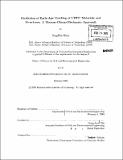| dc.contributor.advisor | Franz-Josef Ulm. | en_US |
| dc.contributor.author | Shim, JongMin, 1975- | en_US |
| dc.contributor.other | Massachusetts Institute of Technology. Dept. of Civil and Environmental Engineering. | en_US |
| dc.date.accessioned | 2006-03-24T18:29:24Z | |
| dc.date.available | 2006-03-24T18:29:24Z | |
| dc.date.copyright | 2005 | en_US |
| dc.date.issued | 2005 | en_US |
| dc.identifier.uri | http://hdl.handle.net/1721.1/30198 | |
| dc.description | Thesis (S.M.)--Massachusetts Institute of Technology, Dept. of Civil and Environmental Engineering, 2005. | en_US |
| dc.description | Includes bibliographical references (p. 152-154). | en_US |
| dc.description.abstract | Ultra-High Performance Concrete [UHPC] has remarkable performance in mechanical properties, ductility, economical benefit, etc., but early-age cracking of UHPC can become an issue during the manufacturing process due to the high cement content and the highly exothermic hydration reaction. Because of the risk of early-age UHPC cracking, there is a need to develop a material model that captures the behavior of UHPC at early-ages. The objective of this research is to develop a new material model for early-age UHPC through a thermodynamics approach. The new model is a two-phase thermo-chemo-mechanical model, which is based on two pillars: the first is a hardened two-phase UHPC material model, and the second is a hydration kinetics model for ordinary concrete. The coupling of these two models is achieved by considering the evolution of the strength and stiffness properties in the two-phase UHPC material model in function of the hydration degree. The efficiency of the model and finite element implementation is validated with experimental data obtained during the casting of a DuctalTM optimized bridge girder. Based on some decoupling hypothesis, the application of the early-age UHPC model can be carried out in a two-step manner: the thermo-chemical problem is solved first, before solving the two-phase thermochemomechanical problem. It is shown that the newly developed model is able to accurately predict temperature history and deformation behavior of the bridge girder. Furthermore, with this versatile engineering model, it is possible to predict the risk of cracking, and eventually to reduce it. | en_US |
| dc.description.statementofresponsibility | by JongMin Shim. | en_US |
| dc.format.extent | 159, [13] p. | en_US |
| dc.format.extent | 7805482 bytes | |
| dc.format.extent | 7826831 bytes | |
| dc.format.mimetype | application/pdf | |
| dc.format.mimetype | application/pdf | |
| dc.language.iso | eng | en_US |
| dc.publisher | Massachusetts Institute of Technology | en_US |
| dc.rights | M.I.T. theses are protected by copyright. They may be viewed from this source for any purpose, but reproduction or distribution in any format is prohibited without written permission. See provided URL for inquiries about permission. | en_US |
| dc.rights.uri | http://dspace.mit.edu/handle/1721.1/7582 | |
| dc.subject | Civil and Environmental Engineering. | en_US |
| dc.title | Prediction of early-age cracking of UHPC materials and structures : a thremo-chemo-mechanics approach | en_US |
| dc.type | Thesis | en_US |
| dc.description.degree | S.M. | en_US |
| dc.contributor.department | Massachusetts Institute of Technology. Department of Civil and Environmental Engineering | |
| dc.identifier.oclc | 60688567 | en_US |
